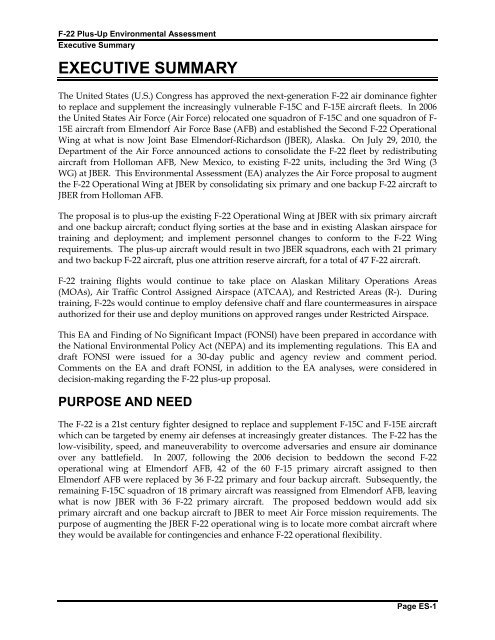F-22 Plus-Up Environmental Assessment - Joint Base Elmendorf ...
F-22 Plus-Up Environmental Assessment - Joint Base Elmendorf ...
F-22 Plus-Up Environmental Assessment - Joint Base Elmendorf ...
Create successful ePaper yourself
Turn your PDF publications into a flip-book with our unique Google optimized e-Paper software.
F-<strong>22</strong> <strong>Plus</strong>-<strong>Up</strong> <strong>Environmental</strong> <strong>Assessment</strong><br />
Executive Summary<br />
EXECUTIVE SUMMARY<br />
The United States (U.S.) Congress has approved the next-generation F-<strong>22</strong> air dominance fighter<br />
to replace and supplement the increasingly vulnerable F-15C and F-15E aircraft fleets. In 2006<br />
the United States Air Force (Air Force) relocated one squadron of F-15C and one squadron of F-<br />
15E aircraft from <strong>Elmendorf</strong> Air Force <strong>Base</strong> (AFB) and established the Second F-<strong>22</strong> Operational<br />
Wing at what is now <strong>Joint</strong> <strong>Base</strong> <strong>Elmendorf</strong>-Richardson (JBER), Alaska. On July 29, 2010, the<br />
Department of the Air Force announced actions to consolidate the F-<strong>22</strong> fleet by redistributing<br />
aircraft from Holloman AFB, New Mexico, to existing F-<strong>22</strong> units, including the 3rd Wing (3<br />
WG) at JBER. This <strong>Environmental</strong> <strong>Assessment</strong> (EA) analyzes the Air Force proposal to augment<br />
the F-<strong>22</strong> Operational Wing at JBER by consolidating six primary and one backup F-<strong>22</strong> aircraft to<br />
JBER from Holloman AFB.<br />
The proposal is to plus-up the existing F-<strong>22</strong> Operational Wing at JBER with six primary aircraft<br />
and one backup aircraft; conduct flying sorties at the base and in existing Alaskan airspace for<br />
training and deployment; and implement personnel changes to conform to the F-<strong>22</strong> Wing<br />
requirements. The plus-up aircraft would result in two JBER squadrons, each with 21 primary<br />
and two backup F-<strong>22</strong> aircraft, plus one attrition reserve aircraft, for a total of 47 F-<strong>22</strong> aircraft.<br />
F-<strong>22</strong> training flights would continue to take place on Alaskan Military Operations Areas<br />
(MOAs), Air Traffic Control Assigned Airspace (ATCAA), and Restricted Areas (R-). During<br />
training, F-<strong>22</strong>s would continue to employ defensive chaff and flare countermeasures in airspace<br />
authorized for their use and deploy munitions on approved ranges under Restricted Airspace.<br />
This EA and Finding of No Significant Impact (FONSI) have been prepared in accordance with<br />
the National <strong>Environmental</strong> Policy Act (NEPA) and its implementing regulations. This EA and<br />
draft FONSI were issued for a 30-day public and agency review and comment period.<br />
Comments on the EA and draft FONSI, in addition to the EA analyses, were considered in<br />
decision-making regarding the F-<strong>22</strong> plus-up proposal.<br />
PURPOSE AND NEED<br />
The F-<strong>22</strong> is a 21st century fighter designed to replace and supplement F-15C and F-15E aircraft<br />
which can be targeted by enemy air defenses at increasingly greater distances. The F-<strong>22</strong> has the<br />
low-visibility, speed, and maneuverability to overcome adversaries and ensure air dominance<br />
over any battlefield. In 2007, following the 2006 decision to beddown the second F-<strong>22</strong><br />
operational wing at <strong>Elmendorf</strong> AFB, 42 of the 60 F-15 primary aircraft assigned to then<br />
<strong>Elmendorf</strong> AFB were replaced by 36 F-<strong>22</strong> primary and four backup aircraft. Subsequently, the<br />
remaining F-15C squadron of 18 primary aircraft was reassigned from <strong>Elmendorf</strong> AFB, leaving<br />
what is now JBER with 36 F-<strong>22</strong> primary aircraft. The proposed beddown would add six<br />
primary aircraft and one backup aircraft to JBER to meet Air Force mission requirements. The<br />
purpose of augmenting the JBER F-<strong>22</strong> operational wing is to locate more combat aircraft where<br />
they would be available for contingencies and enhance F-<strong>22</strong> operational flexibility.<br />
Page ES-1
















